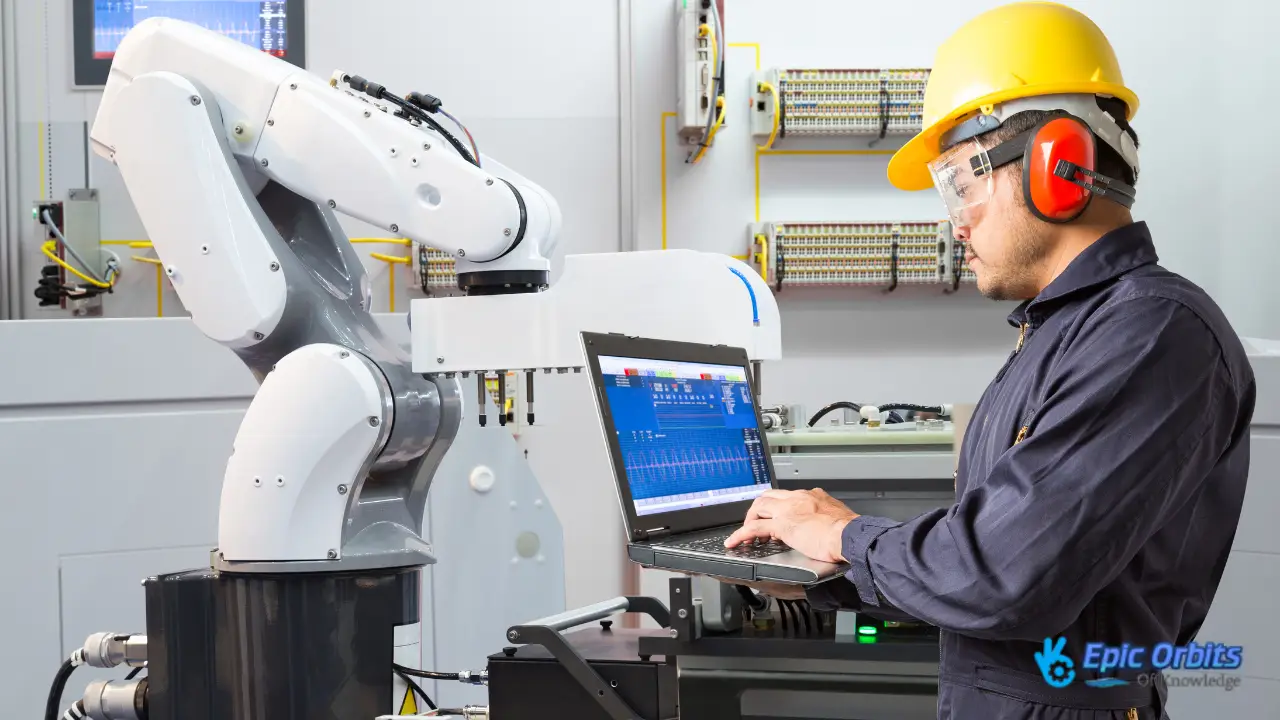Understanding the Basics of Robot Design and Engineering
Get started with Robot Engineering: A step-by-step guide to designing and building robots for the future. Expert tips and insights are included.

We expect the robotics sector to grow to $135 billion by 2025 as automation and artificial intelligence improve. The demand for skilled robotics professionals is rising as automation transforms industries worldwide. Robotics is a discipline that blends ideas from mechanical, electrical, and computer engineering to design, construct, and run complex systems.
This complete book will cover the most important parts of robot design, the abilities needed to be successful in this discipline, and the future of robotics engineering. Robotics is changing the way we work and live in many fields, including manufacturing, healthcare, aerospace, and consumer goods.
The Basics of Robotics Engineering
Robotics engineering is basically the combination of electrical, mechanical, and computer engineering. This discipline that combines many different areas of study is crucial for designing, developing, operating, and engineering robots and robotic systems.
Robotics engineering is a kind of engineering that deals with making, building, and using robots. It uses ideas from mechanical, electrical, and computer engineering to create automated systems that can do things that are laborious, hazardous, or impossible for people to do.
Robotics engineering is a topic that combines ideas from many different areas of engineering. This integration makes it possible to create advanced robotic systems that can see, think, and act in complicated settings.
| Discipline | Role in Robotics Engineering |
| Mechanical Engineering | Design and construction of robotic structures and mechanisms |
| Electrical Engineering | Development of power systems and electronic components |
| Computer Engineering | Programming and control of robotic systems |
Basic Parts of Robot Design
When designing robots, engineers from different fields work together to ensure that they work. When robotics engineers make robots, they have to consider several important parts.
The physical structure of a robot is made up of mechanical systems that control how it moves and interacts with its surroundings. For a robot to move and work, it needs parts like actuators, joints, and end effectors.
Power supplies, motors, microcontrollers, and circuit boards are all examples of electrical parts that provide robots the power and control they need to work. A robot's performance and efficiency depend on how well its parts are chosen and assembled.
Robots can see what's around them thanks to sensors that use different detecting technologies, such as cameras, LiDAR, and proximity sensors. For a robot to be able to receive information and react appropriately, these sensors need to work together.
| Component | Function | Examples |
| Mechanical Systems | Physical Structure and Mobility | Actuators, Joints, End Effectors |
| Electrical Components | Power and Control | Power Supplies, Motors, Microcontrollers |
| Sensors | Environmental Perception | Cameras, LiDAR, Proximity Sensors |
Programming and Control Systems
Robotics is based on programming and control systems, which let robots interact with and adapt to their surroundings. Robotics engineers use programming languages like C++, Python, or specific robot operating systems (ROS) to develop software that tells robots and robotic systems how to move and act.
Python, C++, and Java are some of the most frequent programming languages used in robotics. Robot Operating System (ROS) and other specialized frameworks provide developers more tools for making robots. The robot application’s needs, like performance, usability, and compatibility with hardware, will determine the programming language you choose.
Control algorithms use sensor data to figure out what the robot should do. They commonly use feedback loops to change the robot's behavior depending on how the environment is changing. Motion planning algorithms let robots go about quickly by finding the best pathways and avoiding obstacles. Combining machine learning and artificial intelligence is improving robotic control systems.
The Process of Designing a Robot
Planning and carrying out the robot design process is a complex task that demands a lot of attention to detail. It has various steps, from coming up with the idea to putting it to use and ensuring that the finished product fulfills certain needs and works as planned.
The first step in designing a robot is to come up with an idea. This is when engineers figure out what issue the robot has to answer and what it needs to do. Requirements analysis is the process of figuring out the functional requirements, performance criteria, environmental limitations, and user demands that will shape the design process.
Prototyping lets engineers make early prototypes of the robot to test ideas, confirm their assumptions, and identify problems before starting full production. Testing is an important step when robotics experts check to see whether the robot meets all of the standards, such as safety, dependability, efficiency, and usefulness.
| Stage | Description |
| Conceptualization | Identify the problem and define requirements |
| Prototyping | Create preliminary versions to test concepts |
| Testing | Evaluate performance against established requirements |
Robot design is an iterative process that comprises several rounds of testing, assessment, and improvement to improve the robot and resolve any problems. It is important to keep records throughout the design process so that information is preserved, repeatability is guaranteed, and future changes or upgrades are easier to make.
“The key to designing a successful robot is its iterative process, in which ongoing testing and improvement lead to a stronger and more reliable robotic system.”
When designing a robot, it's crucial to consider the manufacturing process and the selection of materials. This will make sure that the robot can be made quickly and cheaply. The last step in the design process is to test the robot in real-world situations to ensure it meets all specifications and is ready for use.
What You Need to Know to Be a Robot Engineer
Robotics engineers need a wide range of talents, from technical know-how to the ability to solve problems. Engineers need to know a lot about many different fields to design, develop, test, and run robots and robotic systems well.
Robotics engineers need to know a lot about mechanical engineering, electronics, computer languages, and control systems theory. To comprehend robot kinematics, dynamics, and control algorithms, you need to be proficient in math, especially linear algebra, calculus, and statistics. Engineers also need to know how to use CAD software so they can develop and test robotic parts and systems before making physical prototypes.
- It is essential for engineers to be proficient in programming languages such as Python, C++, and MATLAB.
- Know how to use microcontrollers, sensors, actuators, and other hardware parts.
- Proficiency in control systems theory and its application to robots is also essential.
Soft skills are equally important, and effective communication is key to working with other teams and explaining complex ideas to non-technical people. Robotics engineers need problem-solving abilities to figure out how to resolve problems, improve performance, and come up with new ways to solve complex technical challenges. Engineers may use their project management skills to plan and carry out complicated development procedures, ensure that resources are used wisely, and finish projects on schedule and under budget.
“Being able to explain complicated ideas in simple terms is a sign of a good robotics engineer.”
Ways to learn about robotics engineering
Robotics engineering is moving forward quickly; therefore, students need to have many options for education that will help them confront the problems ahead. As robots become more common in several fields, the need for qualified engineers who can build, maintain, and improve robotic systems is growing.
There are currently degree programs in robotics engineering at both the undergraduate and graduate levels at universities. Usually, these curricula include classes in programming, electronics, mechanics, and control systems. For example, Michigan Tech's Department of Electrical and Computer Engineering has a bachelor's degree program in robotics engineering that lets students construct robots, come up with novel uses for them, and do research.
- You can begin your journey in robotics engineering with a bachelor's degree in mechanical engineering, electrical engineering, or computer science.
- More and more specialized robotics programs are becoming accessible, giving students both practical and theoretical understanding.
- Master's and doctorate degrees let you focus further on fields like medical robotics and autonomous systems.
In addition to formal degree programs, professional certifications and continuous education are also important in the field of robotics engineering. Certifications in certain robotics technologies or platforms might show prospective employers that you are an expert in that area.
- Engineers may keep up with new technology by taking online courses, seminars, and bootcamps.
- It's important to have hands-on experience via internships, lab work, and research projects to learn useful skills.
Job Options in Robot Engineering
The industry of robotics engineering is rapidly expanding, offering numerous job opportunities across diverse fields. Robotics engineers help develop robotic systems that do tasks for people and animals. These systems make a big impact in the world.
Robotics engineers work in a wide range of fields, such as healthcare, manufacturing, aerospace, military, agriculture, and consumer electronics. They make automated solutions for assembly lines and quality control in factories. Robotics engineers work in the healthcare field to develop surgical robots and gadgets for rehabilitation.
- Manufacturing: Automated systems for quality control and assembly lines.
- Healthcare: robots for surgery, equipment for rehabilitation, and automated lab systems.
- Aerospace and Defense: Drones and robots that explore space.
Robotics engineers may work as robotics design engineers, control systems engineers, robotics software developers, or integration specialists, among other things. Some of the tasks include creating robotic systems, writing control algorithms, testing and confirming performance, and fixing problems.
- The tasks also include the creation and design of robotic systems.
- The tasks also involve the creation of control algorithms and the evaluation of their effectiveness.
- Fixing problems and writing down technical details.
How much robotics engineers make and what their job prospects are
As robotics becomes better, the job prospects and pay for robotics engineers are becoming better and better. Robotics engineers make a lot of money, and their pay is higher than average at every level of their employment.
The typical compensation for robotics engineers changes a lot depending on how much experience they have.
- Entry-level robotics engineers usually make between $80,000 and $90,000 a year.
- People who have been working for 5 to 10 years may expect to earn between $100,000 and $120,000.
- Senior robotics engineers frequently make more than $130,000 a year, and the best ones may make $150,000 or more.
Location, education, and industry are some of the other things that affect compensation.
The US Bureau of Labor Statistics says that the number of people employed in mechanical engineering, including robotics, will expand by 11% from 2023 to 2033. This is a positive sign for robotics engineers.
- More and more businesses are using automation, which is boosting the need for robotics experts.
- There is a pressing need for robotics engineers that know a lot about new technologies like collaborative robots and autonomous systems.
- Many robotics engineers get more than just a basic income. They often receive incentives and perks packages.
This rise shows that there are many jobs available for robotics experts with excellent pay.
The Future of Engineering in Robotics
As technology becomes better, robotics engineering will change many parts of society. The combination of new technology and trends is about to change industry, everyday lives, and the way society is set up.
Robotics is making a lot of progress because of technologies like artificial intelligence (AI), machine learning, and the Internet of Robotic Things (IoRT). These new ideas make robots smarter, more adaptive, and able to work on their own. AI, for example, lets robots see and respond to their surroundings, which makes them very useful in many situations.
- Robots' ability to see and understand things is becoming better because of improvements in sensor technology and computer vision.
- Soft robotics is a new and exciting subject that is making robots that can move about like living things.
Collaborative robots, or cobots, are designed to operate securely with people. They combine the flexibility of people with the accuracy of robotics. Adding AI to robotics engineering makes these systems even better, allowing for smarter and more efficient automation. As robotics engineering becomes better, we may look forward to seeing AI and collaborative robots used in increasingly advanced ways in many fields.
Conclusion
Taking up the difficulties and possibilities in robot engineering may lead to a fulfilling career and help make big advances in technology. To be successful, you need to have a strong background in the right technical fields. It's important to work on both your technical and soft abilities, as well as get some hands-on experience via projects and internships. Keeping up with new technology and meeting experts may help you learn new things and find job prospects. As automation changes our environment, robotics engineers can affect the future in a way that few other jobs do. This makes it an intriguing and gratifying career path.



